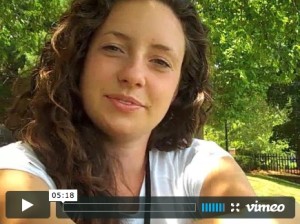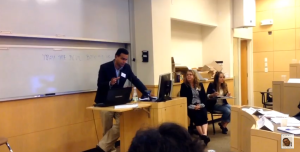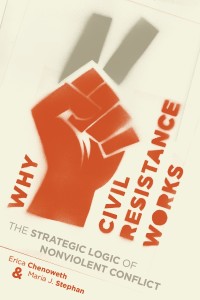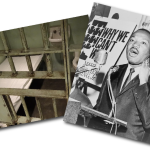The Fletcher Summer Institute for the Advanced Study of Nonviolent Conflict is the only executive education program in the advanced, interdisciplinary study of nonviolent conflict, taught by leading scholars and practitioners of strategic nonviolent action and authorities from related fields.
In 2010, international professionals, leaders of indigenous NGOs, journalists, campaign organizers, issue advocates and educators from twenty-nine countries around the world came together for six days at the Fletcher School of Law and Diplomacy in Medford, Massachusetts to learn about and discuss nonviolent conflict and civil resistance.
Be a part of the experience…
Keynote Address
Rev. James Lawson, Distinguished University Professor at Vanderbilt University
Prolific civil rights leader and trainer of nonviolent action, Rev. James Lawson, delivers the opening banquet keynote address talking about his experience organizing and training activists in the Civil Rights Movement, particularly the Nashville lunch counter sit-ins.
Additional Resources:
- Ackerman, Peter & DuVall, Jack. A Force More Powerful: A Century of Nonviolent Conflict. New York, NY: St. Martin’s Press, 2000.
- York, Steve. A Force More Powerful (DVD). September, 2001
- WATCH Rev. James Lawson talk about training for nonviolent resistance
- WATCH Rev. James Lawson talk about Gandhian nonviolence
- Ackerman, Peter & DuVall, Jack. A Force More Powerful: A Century of Nonviolent Conflict. New York, NY: St. Martin’s Press, 2000.
- Ackerman, Peter & DuVall, Jack. The Right to Rise Up: People Power and the Virtue of Civic Disruption. Fletcher Forum of World Affairs. Tufts University, May 2006.
- Stephan, Maria & Chenoweth, Erica. Why Civil Resistance Works: The Strategic Logic of Nonviolent Conflict. International Security. Volume 33, Issue 1.
- LISTEN to a podcast of this presentation
- Strategic Planning and Tactical Choices (Power Point)
- Newhouse, Kara. Building an Authentic Journalism Movement. The Narco News Bulletin. February 21, 2010.
The Dynamics of Civil Resistance
Presenter: Jack DuVall, President of the International Center on Nonviolent Conflict
Jack DuVall looks at how the modern practice of civil resistance sprang from ideas about the underlying nature of political power that began to be framed about 150 years ago. As pioneered by Gandhi and adopted by scores of movements and campaigns for rights and justice in the 20th century, strategies of civil resistance have exhibited a common dynamic, propelled historic changes — and imparted certain political and social properties to the societies they often transformed. The record of the effectiveness of these nonviolent strategies in liberating oppressed people, when compared to that of violent insurgency or revolt, has been remarkable — and suggests why political violence could largely be displaced in the future.
Additional Resources:
Strategic Planning and Tactical Choices
Presenter: Hardy Merriman, Senior Advisor at the International Center on Nonviolent Conflict
Strategic planning and tactical choice are essential considerations in effective civil resistance. This session offers a strategic framework with which to analyze civil resistance movements. It also examines the diversity of tactics available to civil resisters, and explores issues involved in tactical choice, success and failure.
Additional Resources
Mobilization, Leadership, and Coalition Building
Presenter: Dr. Janet Cherry, Senior Lecturer in Development Studies at Nelson Mandela Metropolitan University
These three critical phases in the work of most nonviolent movements are examined in this session, with examples — as in South Africa with the United Democratic Front — illustrating the trajectory of organizing and building a diverse, representative mass movement; the way in which broad unity with a range of allies is constructed; and the nature of leadership.
Social Movements: Power from Above and Below
Presenter: Dr. Doug McAdam, Professor of Sociology at Stanford University
Using the U.S. civil rights movement as the principal example, McAdam talks about the typical mix of top down environmental facilitation and bottom up grassroots activism that fuel successful social movements. Appropriately, FSI puts the emphasis on the latter, but a full understanding of the prospects for significant social change requires that activists understand the critical reciprocal relationship between people power and the shifting environmental circumstances they confront.
Costs and Risks in Nonviolent Conflict
Presenters: Hardy Merriman, Senior Advisor at the International Center on Nonviolent Conflict
Jack DuVall, President of the International Center on Nonviolent Conflict
Every civil resistance movement can be understood as engaging in a contest with an adversary, whether that is a government or other institutional source of injustice or oppression. Movements may use tactics that deny their adversaries legitimacy and material resources, as well as reduce the loyalty of the adversary’s supporters. Conversely, a movement’s adversary may take actions to deny a movement legitimacy, material resources, or the loyalty of the movement’s supporters. All these effects can be understood as costs to the operational capacity of either side. There are also certain risks inherent in the choice of strategy and tactics; imposing costs always entails taking risks. This module will frame civil resistance from the perspective of three kinds of costs and risks: material/economic; political/legitimacy-related; and social/psychological. Successful civil resistance customarily requires planning, which should take costs and risks into account.
The Quiet Revolution in the First Intifada
Presenter: Dr. Mary King, Distinguished Scholar at American University for Global Peace
Mary King offers an overview of the remarkable and previously untold account of the first intifada as a massive nonviolent social mobilization. The Palestinians’ deliberately chosen methods for resisting the Israeli occupation effectively debunk the widely held notion of the first intifada as violent. King will discuss the decades-long spread of knowledge about nonviolent strategies throughout Palestinian society shaped the uprising, which was years in the making, and will offer details on the intifada’s ability to continue despite harsh reprisals. Through the determination of thousands of “popular committees,” often started and run by women, and the ability to sustain communities under curfew or strike, the nonviolent movement during the first intifada was a “quiet revolution” which emerged as the most cogent pressure to date to create a Palestinian state alongside Israel.
Civil Resistance and Democratic Transitions
Presenter: Dr. Maciej Bartkowski, Senior Director, Education and Research at the International Center on Nonviolent Conflict
Dr. Victoria Tin-Bor Hui, Assistant Professor of Political Science at Notre Dame University
Does the use of civil resistance create long-lasting effects on civil society and political life? Does participation in broad-based nonviolent movements instill democratic values, which make democracy more sustainable after a transition? These and other questions help explore what kind of social capital may be created by nonviolent movements, using the case of the Polish Solidarity movement in communist Poland and its residual effect on the Polish society and politics in the immediate and long term perspectives following the 1989 changes.
Citizen Journalism and Digital Resistance
Presenters: Al Giordano, Founder of The Narco News Bulletin
Noha Atef, Founder of TortureinEgypt.net
A movement that makes its own media has considerable advantages and better chances of success than those that must depend on commercial media to tell their story and define their narrative. Narco News publisher Al Giordano and Torture in Egypt publisher Noha Atef, both of the School of Authentic Journalism, share practical tips on citizen media with an emphasis on strategies, tactics and tools for organizers and participants in social movements, nonviolent campaigns and civil resistance.
Additional Resources
Budrus Film Screening
Presenters: Ayed Morrar, Community Organizer at Budrus
Julia Bacha, Director at Budrus
“Budrus” is an award-winning feature documentary film about a Palestinian community organizer, Ayed Morrar, who unites local Fatah and Hamas members along with Israeli supporters in an unarmed movement to save his village of Budrus from destruction by Israel’s Separation Barrier. Success eludes them until his 15-year-old daughter, Iltezam, launches a women’s contingent that quickly moves to the front lines. Struggling side by side, father and daughter unleash an inspiring, yet little-known, movement in the Occupied Palestinian Territories that is still gaining ground today.
After the screening, participants were joined by Ayed Morrar, the film’s protagonist, and Julia Bacha (via Skype) to hear them speak more about the experience of nonviolent resistance in Budrus and the making of the film.
Burma VJ Film Screening
Released in 2008, Burma VJ is a documentary film that looks at brave citizen journalists risking torture and life in jail in order to live the essence of journalism as they insist on keeping up the flow of news from their closed country. The film offers a unique insight into high-risk journalism and dissidence in a police state, while at the same time providing a thorough documentation of the historical and dramatic days of September 2007, when the Buddhist monks started marching. Burma VJ was a Best Documentary nominee at the 2009 Academy Awards.
After the screening, two FSI participants who work with Burmese activists on the Thai/Burma border, spoke about their experience working with individuals and groups involved in the nonviolent struggle against the military junta.
https://www.youtube.com/watch?v=Q2VNqC4xxAU
MEET SOME OF THE PARTICIPANTS
Abebe Gellaw
Abebe Gellaw is an exiled Ethiopian journalist; he is currently a visiting scholar at the Centre on Democracy, Development and the Rule of Law at Stanford University. He is working on a book project, “Ethiopia under Meles: Why the transition from military rule to democracy failed.” He is also a steering committee member of the Solidarity Movement for a New Ethiopia, an organization that seeks to bring about drastic socio-political changes through nonviolent struggle.
Gellaw holds a bachelor’s degree in Political Science and International Relations from the Addis Ababa University and a post-graduate diploma in law from London Metropolitan University. He began his career in journalism in 1993 as a freelance writer focusing on human rights and political issues. He has worked for various print and online publications including the Ethiopian Herald, the only English daily in the country. Most recently he was a recipient of Stanford University’s Knight Journalism Fellowship and Yahoo’s International Fellowship in 2009. His op-eds, stories, articles and interviews have appeared in the Wall Street Journal, The Guardian, the Far East Review, and Global Integrity’s “The Corruption Notebooks 2008.”
My interest in nonviolent struggle was first sparked “…when I got involved in the student union at the Addis Ababa University that was struggling for academic and political freedom. In 1993, 42 professors were fired from the university and the student union was disbanded. I’ve been personally involved in nonviolent action, when as a student I along with others took part in a number of protest rallies, sit-ins and hunger strikes. I have been particularly successful in using journalism as a vehicle of advocacy, mobilizing for a cause and as a means of exposing the abuse of power. I’ve learned that nonviolence is a powerful means to challenge tyranny and dissolve violence.”
https://www.youtube.com/watch?v=ZHlZdgXK_sc
Dr. Mohamed Fouad Bergigui
Dr. Mohamed Fouad Bergigui is the head of rural development for the Moroccan Foundation for Youth, Initiative and Development. He received a Doctor of Veterinary Medicine at the Agronomic and Veterinary Institute. At the foundation, Bergigui is in charge of conception, achievement and follow-up of socio-economic development programs targeting especially rural areas and underprivileged populations. He has participated in many rural development projects such as the creation of six beekeeping cooperatives in Tiznit and Chtouka in southern Morocco, and two Veterinarian Civic Action Projects for poor farmers rural Morocco.
My interest in nonviolent struggle was first sparked “…when I led a rural development project to ensure better living conditions for destitute Berber populations that have no access to the basic necessities of life in the countryside of Morocco. I was personally involved in nonviolent action when I participated in a COP15 youth climate march in Copenhagen. I hope to learn how to empower youth and underprivileged populations to act for the change they need.
https://www.youtube.com/watch?v=3RJ9OKvTj7A&feature=youtu.be
Natalia Lozano Mancera
Nathalie Janne d’Othée was born in Antwerp, Belgium. She studied History and International Relations at the Catholic University of Louvain (UCL) in Belgium. During her university years, her interest in the Middle East increased. She studied at the University of Galatasaray in Istanbul for one year. Then she lived for a year in Cairo to learn Arabic. Coming back to Belgium, she decided to begin a PhD on the Palestinian nonviolent resistance movement, which really impressed her. She also works in a research institute on Euro-Arab relations, called MEDEA. In 2008, she participated in a ten-day project called “Samen in Zee” (Dutch for “Together at sea”) with Europeans, Palestinians and Israelis in the Netherlands. The group received training in nonviolent communication. In 2009, Nathalie travelled three weeks around Israel/Palestine. She is also involved in Belgium with a working group of the International Civil Service, which is an NGO. The working group focuses its work on the Mediterranean region, especially Palestine. It organizes conferences, trainings for volunteers leaving for the region, and participates in demonstrations of solidarity with the Palestinian people and their nonviolent struggle.
My interest in nonviolent struggle was first sparked “…by visiting the numerous blogs of Palestinians telling about their daily life under occupation, and then by a human chain created around the Gaza Strip in the beginning of 2008. I was personally involved in nonviolent actions in Jerusalem and the West Bank in 2009. For instance, I attended a festival meant to show the settlers that a piece of land called Ush Graib was “occupied” by the local Palestinian population. I’ve visited Palestine and participated in nonviolent actions and have learned that the media coverage of a nonviolent action is fundamental for its effectiveness. What I hope to take away from the Fletcher Summer Institute is a better understanding of nonviolent resistance and the role of the media, and also the importance of foreign support to nonviolence.”
https://www.youtube.com/watch?v=L0RQl1jcLqk&feature=youtu.be
Ramesh Chandra Sharma
Ramesh Chandra Sharma has worked with Ekta Parishad, a nonviolent mass movement in India, as a Campaign Coordinator for the past 12 years. He has been involved in campaigning and training rural youth to lead struggles in villages for the past 40 years. He is also in charge of International Coordination for Ekta Parishad. Ramesh is also a member of various groups such as the Task Force for Land Reforms, the Central Enquiry Committee on Tribal Self Rule, and the National Land Reforms Committee. As a campaigner he has been involved in many foot marches, mass movements and negotiations with concerned groups. Ramesh has also delivered lectures at Cambridge University, the London School of Economics, and Oxford University as well as the British Parliamentary Committee. He has been involved in and offered assistance to many similar international nonviolent movements in Paraguay, Argentina, Chile, Venezuela, Bolivia, Colombia, Peru, Costa Rica, Panama, Mexico, Brazil, Bangkok, and Uganda. Currently, he is engaged in building a mass movement in India called Jan Satyagraha 2012 when 100,000 landless and deprived people will walk to claim their land, livelihood, rights and dignity.
“In every nonviolent movement there should be individuals who are part of constructive work while simultaneously strengthening local campaigns. These advocacy efforts lend a transformative, long-term resilience to all stakeholders who are involved with the daily tasks and short-term goals of an organization.”
Nathalie Janee D’Othée
Natalia Lozano Mancera was born in Bogotá, Colombia, where she grew up surrounded by her father’s large family who were all at some point of their lives politically active in leftist movements. Inspired by her family she studied Political Science at the National University of Colombia. Her BA degree thesis was called “Musical Consumption and Production in Internally Displaced People in Bogotá.” Some years afterwards she worked for a govermental organization in charge of reparations for victims of paramilitary groups. Being so close to the situations of the different victims she realized she did not want to work in processes of reparations but in processes that allow people to escape from being victimized. In 2007 she became a student in the MA program in Peace Studies at the University of Innsbruck. She graduated last January with a thesis called “Playing Music Performing Resistance, the dynamics of resistance through music in the Colombia south Pacific coast” in which she analyzes little acts of resistance related to the marimba music. Currently, she works for a NGO in Colombia in which she gives workshops on Conflict Transformation and Peace Education to vulnerable populations. She recently enrolled in the PhD program of Media and Communications of the European Graduate School, where she wants to continue working with the concepts of resistance and revolution in relation to arts and creativity.
My interest in nonviolent struggle was first sparked “…by living in a country where violence is so overwhelming. My interest was also sparked by having the conviction that we as creative human beings have the capacity to transform those violent realities. I’ve been personally involved in nonviolent action, when the current Colombian president wanted to reform the National Constitution in order to run for a third term (he already had changed it to run for the second one). I participated in an organization called Civil Alliance for Democracy that worked against that reform, and any other reform that would threaten the principles of freedom and plurality proclaimed by the Constitution. I’ve learned that there is nothing that can justify the use of violence. There are not fair causes in the name of which violence can be used. I hope to take away from the Fletcher Summer Institute shared moments and knowledge about others’ experiences and about resistance theories that will give me the will to keep on studying and acting in nonviolent movements.”
https://www.youtube.com/watch?v=0flzQOw8o1g&feature=youtu.be
Musa Isah Salmanu
Musa Isah Salmanu is a serving Squadron Leader in the Nigerian Air Force, with an MA in Conflict Security and Development from King’s College London and an MSc in Political Science from Ahmadu Bello University Zaria-Nigeria. He is an African Peace and Security Fellow at the African Leadership Center and the Conflict, Security and Development Group, King’s College London. He is presently deployed as a military observer in South Kivu, Democratic Republic of Congo.
My interest in nonviolent struggle was first sparked “…by the conviction that the ability to exercise our rights to freedom of expression and association is an important step towards achieving a viable and progressive society. I’ve been personally involved in nonviolent action, when as a high school student I worked with other students to organize and challenge a tuition increment by the government, a move we viewed as anti-poor. I’ve lived or worked in a conflict environment, and have learned that the traditional notion of seeing security personnel as pro-establishment and anti-popular movements is erroneous. There is thus the need for security forces to be carried on board and to be more informed about the logic, principles, and ideals behind nonviolent conflict. Presently in the Eastern part of the DR Congo, I have witnessed firsthand how the denial of basic rights and the curtailing of civil liberty can bring about violent resistance and anarchy. What I hope to take away from the Fletcher Summer Institute is a better understanding of the modes and reasons for actions involving nonviolent conflict as this will enable me to deal with situations in a more professional way. This I believe will engender the spirit of mutual understanding between the practitioners of nonviolence and the security agents sent to maintain law and order. Furthermore, I will be better equipped to explain these issues to my colleagues and thereby beginning a process of change in perception and action.”
Tamar Zhvania
Tamar Zhvania received her Sociology MA degree from the Iv. Javakhishvili Tbilisi State University. She is an Expert/Consultant in the United Nations Development Program (UNDP), Electoral Assistance Project since November 2007, acting as the Project Manager. During the last three years she has actively worked on public awareness and civic education, supported capacity building of different institutions as well as promoted improved legal framework for effective democratic processes.
From 2004-2007, Tamar worked at a well-known Georgian NGO called the International Society for Fair Elections and Democracy (ISFED) as an Executive Director. In 2001-2004, before assigning as an ISFED Executive Director, Tamar worked for ISFED as a Press-Secretary and then was promoted as a PR Director. In 2000, she worked as an ISFED representative in the Central Election Commission (CEC) of Georgia. Tamar has experience of working in Bangladesh as NDI election consultant, in Ukraine under ENEMO observation missions, in Kazakhstan under OSCE observation missions and in Norway under NUPI short-term electoral mission.
“Since 2008 there have been frequent rallies and public meetings in Georgia, especially election related public protests and boycotts. Many political parties, particularly opposition ones, encouraged people to be involved in the public protests to demand government change through snap elections to be conducted in free and fair manner. People also were raising concerns related to social and political problems. Those protests were organized in terms of representing the different parties, social groups and the public in general.”
https://www.youtube.com/watch?v=bivdnlAkCYU&feature=youtu.be


 A co-production of The International Center on Nonviolent Conflict (ICNC) and York Zimmerman Inc.
A co-production of The International Center on Nonviolent Conflict (ICNC) and York Zimmerman Inc.

